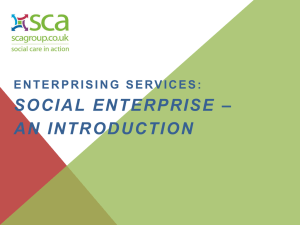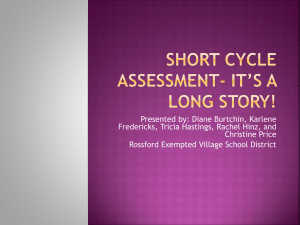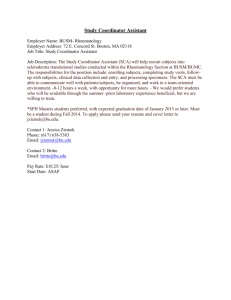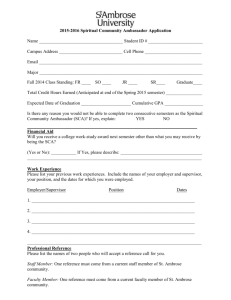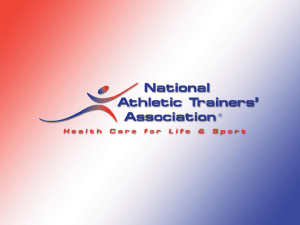Prevention/Treatment Needs Assessment
advertisement
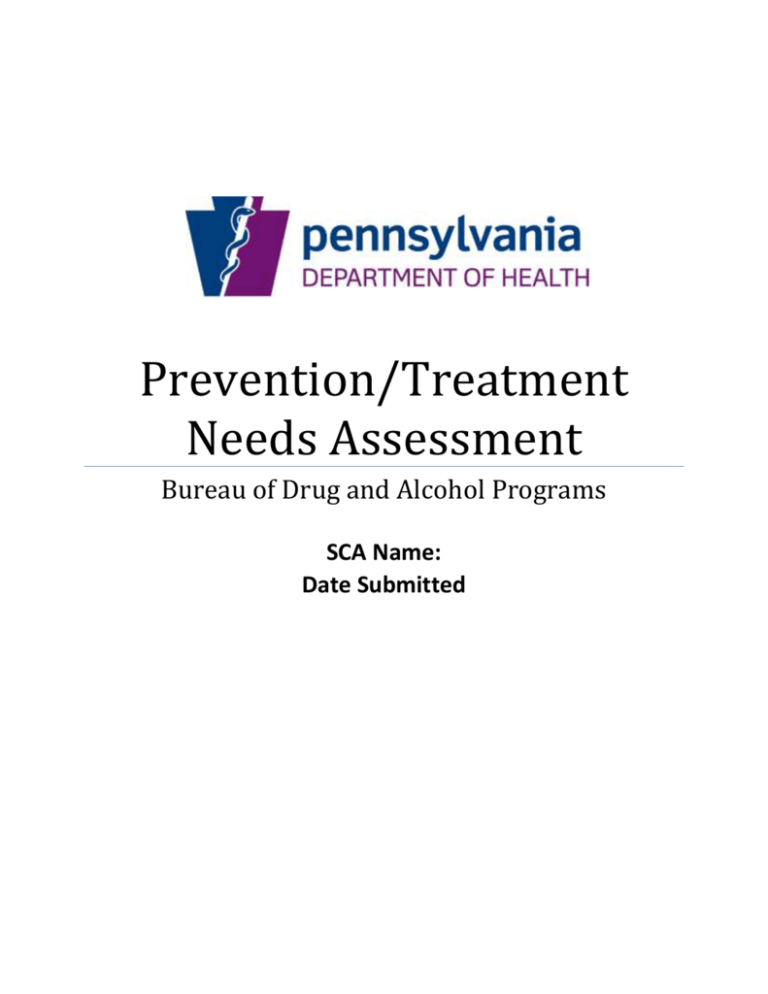
Prevention/Treatment Needs Assessment Bureau of Drug and Alcohol Programs SCA Name: Date Submitted Table of Contents General Information/Instructions ............................................................................................................... 3 SCA/County Information .............................................................................................................................. 5 Objectives ..................................................................................................................................................... 8 Appendix A: Key Representative and Convenience Survey Administration Information (needs to be completed by SCA) ................................................................................................................ 24 Appendix B: Prevalence of substance use disorders in the total population .......................................... 25 Appendix C: Prevalence of substance abuse dependency disorders in special populations (needs to be completed by SCA) ................................................................................................................ 29 Appendix D: BDAP Risk & Protective Factors ............................................................................................ 32 Appendix E: CIS Pattern of Referrals for SCA ............................................................................................ 33 Appendix F: CIS Treatment Admissions by Type of Service ...................................................................... 34 Appendix G: CIS: SCA Paid Admission by Primary Substance of Abuse ................................................... 35 General Information/Instructions Read all directions before completing this needs assessment. It is the intent of the Bureau of Drug and Alcohol Programs (BDAP) to further enhance and improve substance abuse prevention, intervention, treatment, and recovery policies and practices throughout the commonwealth. This work is carried out in conjunction with Single County Authorities (SCAs), their contracted providers and the community at large. As a result, the SCAs have flexibility to develop their service delivery system in response to community needs. The SCA has the role of planning and coordinating all substance abuse services in the county(ies) it serves. In order to effectively plan and coordinate services, a needs assessment is required. This needs assessment combines the former Prevention Needs Assessment and Treatment Needs Assessment into one comprehensive needs assessment. The process involves the identification, collection, analysis, and synthesis of data to define problems within a geographic area. This needs assessment will be the foundation for your Prevention/Treatment Comprehensive Strategic Plan. Many of the issues/needs/resources you identify here will become the focus of your plan. Although your needs assessment will be used in planning, keep in mind that issues/needs/resources that you identify need to be discussed regardless of whether they will be something you plan to address. This is particularly important because BDAP will use the information from these needs assessments to help guide the State Plan. The needs assessments will also be used by BDAP to identify common or unmet needs across SCAs, and determine possible avenues for addressing these issues at the state level. This needs assessment should utilize a data driven decision-making process. Areas of need/problems that are discussed in this needs assessment report must be identified using the best available data sources. The needs assessment team that you have assembled should work to identify and collect the data necessary to determine the needs of your population. The needs assessment team should also work to determine what resources are currently available to meet identified needs. When reviewing data it is important the needs assessment team thinks about factors that may be skewing or biasing the data and how representative the data may (or may not) be for certain populations. Suggested and required data sources have been provided to you throughout this document. These are by no means an exhaustive list of possible data sources. Feel free to seek out and discuss data other than what has been noted in this document when responding to the questions and objectives below. The SCA shall submit the combined Prevention/Treatment Needs Assessment to BDAP in accordance with the BDAP Report Schedule. The SCA must submit the Prevention/Treatment Needs Assessment in the template provided. Do not delete the headings, questions, objectives and sub-objectives from the template; insert the corresponding narrative where directed. Directions are provided for the completion of each section. These directions provide essential information to be able to respond correctly to each section. Please read all directions before completing any section, appendix, question, or objective. Clarifying examples and definitions have been provided as a guide. Appendices have also been provided for your reference to assist in the completion of each section. There are no requirements regarding length of responses for any question or objective. It is understood that SCAs cannot discuss every relevant data finding or other piece of information. SCAs are expected to use their best judgment to determine how lengthy each response needs to be. Included with this template document is a copy of the BDAP Key Representative Survey on Alcohol, Tobacco and Other Drugs and the BDAP Convenience Survey on Alcohol Tobacco and Other Drugs along with directions for these surveys. You are required to administer the Key Representative Survey, but the Convenience Survey is optional. Information about how you administered these surveys must be recorded on Appendix A. Please note that review and analysis of secondary data sources (i.e. data collected by someone other than the SCA) must take place before starting the process of primary data collection through the Key Representative Survey. Analysis of secondary data sources will provide the information needed to identify the “high risk” communities where they Key Representative Survey should be administered. It may also be necessary to collect additional data (beyond the Key Representative and Convenience Surveys) from focus groups, public forums, interviews, etc. Remember to cite the source of all data or other findings that you refer to in your responses. Please make sure your needs assessment addresses the entire county(ies) you serve. Even though you may not be able to address all the issues identified through this needs assessment, this should be a comprehensive process in which you examine all communities in each county you serve. While completing this needs assessment include discussion of needs, resources, etc. for not just the SCA but the county(ies)/communities as a whole. * Note to Joinders – SCAs who are joinders must address each element of the SCA/County Information section for each county. If information is the same for multiple counties be sure to note that. When completing the objectives each county must also be addressed. Be sure to cite data and other findings for each county. SCA/County Information Reminder: Please provide the requested information about each of the counties served by your SCA. Enter your responses into the following template. Please note the source of any data you provide in your responses. SCA Information: a. Please describe how your SCA functions in terms of what services (e.g. prevention programming, screenings, assessments, case management, treatment) are provided/conducted by the SCA and which are contracted out to providers. (Use space provided below. Add additional space as needed.) Population Trends and Demographics: a. List trends in population growth/movement and demographics (i.e. rapid population growth, changes in demographics such as an aging population or new populations coming in or leaving area) – List only trends that are impacting substance use/abuse and the prevention, intervention, treatment of and recovery from substance abuse. (Use space provided below. Add additional space as needed) b. Outline cultural/religious/ethnic groups in your county(ies) that may be important subpopulations or communities that need to be addressed as you plan prevention, intervention, treatment, and recovery services. Cultural groups can be defined as groups of people that share common ties of language, nationality, practices, or some other set of shared experiences. (Use space provided below. Add additional space as needed.) Community Changes: a. List any significant changes in your county(ies) in the last five years. This could include social and economic conditions, new businesses or loss of businesses, a new school or school closing, new places of worship or closing of places of worship, and more. This could also include changes to law enforcement including changes to local laws, ordinances, funding, etc. – List only trends that are impacting substance use/abuse and the prevention, intervention, treatment of and recovery from substance abuse. (Use space provided below. Add additional space as needed) History and Traditions: a. Describe how the history of the county(ies) influences how people feel about the county(ies), and how people view substance use/abuse and the prevention/treatment of substance abuse. Note traditions and celebrations that are relevant to substance use/abuse and the prevention, intervention, treatment of and recovery from substance abuse. (Use space provided below. Add additional space as needed) Educational Institutions: a. Describe how engaged schools in your county(ies) are in prevention/intervention programming. Include public, private, and charter schools in your discussion. Describe to what extent schools are willing to cooperate in providing prevention/intervention programs and services. Are schools unwilling to provide any such programming? Are schools willing to work with the SCA and providers to implement needed programs and services even if barriers such as lack of time exist? (Use space provided below. Add additional space as needed) b. Pennsylvania Youth Survey (PAYS) and Youth Risk Behavior Survey (YRBS) Participation – Please list the school districts you are aware of that are participating in PAYS and/or YRBS. For each school district also note the school buildings and grades in which the surveys are administered. (Use space provided below. Add additional space as needed) Resources: a. List all sources of additional grant funding for prevention, intervention, treatment and recovery coming to the SCA (do not include pass through funding or funding that goes directly to your contracted providers). (Complete table below. Add rows to table as needed.) Name of Funding Source Brief Description of Grant Start Date End Date Objectives 1 To obtain a.) information regarding use of ATOD and b.) an estimate of the prevalence of substance use disorder in the total population of an SCA. Definitions Estimate: A quantitative description of the current or past situation, based on data from known sources relating to the same time period using a known method which can be replicated. Prevalence: The number with a diagnosable condition at a given time. Substance use disorder: A condition of substance abuse or dependency as defined by DSM IV-TR. Total Population: All people who are located in the geographic region of the SCA. Directions for 1a. Utilizing a variety of data sources, discuss the use of ATOD for the counties you serve. Information regarding substance use would include age at first use, past 30 day use, and other rates of use for various populations. The goal is to determine what substances are being used, at what rate, where, and by whom. Focus your response on issues and populations that the data suggest may be the biggest concerns. Note any gaps in available data that you believe may be obscuring to what extent certain issues/problems exist. Examples of data gaps include: the ER department at the regional hospital was unable to provide any data regarding ER visits and two school districts in your county have not participated in PAYS, which has limited your ability to assess patterns of use for that population. Where possible, list not only county level data but also community level data. (The term community can have many different meanings and can carry different connotations. It can mean town, township, borough, certain number of blocks within a city, or even a specific demographic group.) Sources of this data include arrest reports, Uniform Crime Reporting System (UCR), emergency room admissions, and surveys such as Pennsylvania Youth Survey (PAYS) and Youth Risk Behavior Survey (YRBS). Data from AOPC (Administrative Office of Pennsylvania Courts) on offenses charged for crimes such as DUI, drug-related offenses, and underage drinking for the county(ies) you serve has been provided to you in tables posted to the BDAP Communicator. You are required to discuss this provided AOPC data in your response. You are also required to include data you have entered into PBPS such as NOMs surveys and pre/post tests in your response. Utilize service location information in PBPS to link this data to specific communities. Please compare local data to state and national data. Other local data you have collected can also be discussed in response to this objective. Response to 1a. (Insert response below.) Directions for 1b. Appendix B provides a table showing the prevalence of substance use disorders in the total population. Appendix C provides a table of the prevalence of substance use disorders by local special populations. The table in Appendix B has been completed for you, but you must complete the table in Appendix C. Instructions for the completion of the table in Appendix C have been included with the table. Certain special populations have been defined for you, but you may include other special population categories (e.g. co-occurring) as desired. If you add special populations, the additional populations must be added as new rows in the table. After completing the table in Appendix C and reviewing the information in Appendix B and C, briefly describe the extent of substance use disorders in the county(ies) you serve. You are not limited to only the data sources provided to you in Appendix B and C. You may also collect and/or discuss other local data sources that provide additional information regarding the extent of substance use disorders in the county(ies) you serve. Response to 1b. (Insert response below.) 2 To identify risk and protective factors, in regard to the prevention of substance abuse, that are present in the communities served by your SCA. Definitions Risk Factor: Risk factors are individual characteristics and environmental influences associated with an increased vulnerability to the initiation, continuation, or escalation of substance use. Protective Factor: Protective factors include individual resilience and other circumstances that are associated with a reduction in the likelihood of substance use. Directions for 2 Please use data such as Key Representative Surveys or focus groups to support your claims. See Appendix D for a list of risk and protective factors. Risk factors can increase a person’s chances for substance use/abuse, while protective factors can reduce the risk. For the risk and protective factors you identify also remark on their changeability, i.e. how possible or difficult would it be to change these factors. Reminder: Please complete Appendix A – Key Representative and Convenience Survey Administration Information. Response to 2 (Insert response below.) 3 To identify local, state, and national trends that may impact the SCA and may influence prevention, intervention, treatment and recovery efforts. Definitions: Local, state, and national trends: A prevailing tendency or information relating to the economy, government, legal issues, technological and medical advances, or socio-cultural patterns that may influence business practices of the SCA. Intervention: Intervention focuses on providing individuals who engage in hazardous substance use services to develop the skills necessary to reduce their risk. Intervention services may also be provided for individuals who need substance use disorder treatment but are unable to access treatment. The goal of intervention is to enhance and maintain the individual’s motivation to access and engage with appropriate substance use services. Intervention also includes Early Intervention, which is defined as follows: Early Intervention is a term generally used to describe those early efforts to intervene where an individual is seen as being at risk. An early intervention is often brief, designed to assess and provide some initial feedback to the individual about his or her alcohol or other drug (AOD) use and its consequences. Early Intervention takes place prior to a Level of Care Assessment. Examples: Student Assistance Program, Underage Drinking Program, DUI Offender Program. Directions for 3 Describe local, state, and national trends that may impact the SCA and may influence prevention, intervention, treatment and recovery efforts. Examples of local, state, or national trends may include a move to integrated health/behavioral health care, local unemployment rates, aging of “baby boomers,” electronic medical records, implementation of evidencebased/promising practices, focus on special initiatives (i.e., Underage Drinking, offender reentry, co-occurring), medication management, political priorities, changes in laws or local ordinances, school policies and federal education requirements, etc. Response to 3 (Insert response below.) 4 To identify emerging substance use problems by type of chemical, route of administration, population, availability and cost, etc. Definitions: Emerging substance use problems: This implies that there is a situation which is different from what came before, and which could not have been fully anticipated and planned for. For the purposes of this needs assessment consider emerging to be something that arose within the last two years or since your last plan was completed. The difference may be the population of users, the type of substance, the nature of the substance or the rate of increase. The implication is that a new problem confronts the community and it may need to be dealt with. The new problem may be an isolated event that requires immediate action or it may take the form of a gradual pattern change that was initially anecdotal information, tracked over time, and now requires a response impacting service delivery. Directions for 4 Discuss any emerging substance use problems. These may have been problems you discussed in Objective 1, but please note them again here in regard to their emerging nature. For example: you may describe new substances such as synthetic drugs that have taken off in popularity or you may note the growing use of heroin in a specific population such as children of middle/upper class. Also identify in your response any indicators of emerging treatment needs for the SCA. Note that only those indicators of an emerging treatment need should be included in your discussion. Examples of changes that may indicate a growth in the need for treatment are: an increase in DUI offenders based on reduction of BAC level to .08, an increase in methamphetamine labs, identification of new drugs of abuse, or an increase in the number of inmates released from state/county probation and parole. Be sure to note the data and source of the data that is evidence of the emerging substance use problems you discuss in your response. Sources of data may include: Client Information System (CIS), Case Management Resource Report (CMRR), anecdotal information obtained from treatments providers, police, probation/parole officers or human service staff, emergency room data, arrest data, and Student Assistance Program (SAP) data, or any other local data sources you have. Response to 4 (Insert response below.) 5 To identify demand. a. Identify demand for prevention services. b. Identify demand for intervention services. c. Identify demand for treatment services. d. Identify demand for recovery support services. Definitions Prevention Demand: Organizations or individuals seeking specific prevention services or programming. Intervention Demand: Organizations or individuals seeking specific intervention services or programming. Treatment Demand: The number of people who will seek treatment for a substance use disorder. Recovery Demand: The number of people who will seek recovery support services. Directions for 5a. Discuss the number of organizations or individuals that requested specific prevention services or programs from the SCA and your contracted providers for the past state fiscal year (2010/2011). Identify who the requests came from, and the number of requests received. Note whether you have been able to meet this demand or if there are requests for prevention services that you are unable to address due to a lack of resources. Resources can be money, staff, time, etc. Example: A local school district has requested that you provide Project Northland, but you do not currently have the funding to do so. It is understood that you may not have been formally tracking these types of requests. In this case please provide, based on any informal records you may have, information regarding requests for prevention services or programs. You will be required in your Prevention/Treatment Comprehensive Strategic Plan to describe your plan for how you will track this information. Response to 5a. (Insert response below.) Directions for 5b. Discuss the number of organizations or individuals that requested specific intervention services from the SCA and your contracted providers for the past state fiscal year (2010/2011). Identify who the requests have come from, and the number of requests received. Note whether you have been able to meet this demand or if there are requests for intervention services that you are unable to address due to a lack of resources. Resources can be money, staff, time, etc. Please address this objective in regard to intervention and early intervention as defined in Objective 3. Example: A Boys & Girls Club would like to start an underage drinking program for adolescents who have related charges against them. The Boys & Girls Club contacts a local provider to see if they could provide such a program. The provider is unable to provide the program because they would need additional qualified staff in order to make the program available. It is understood that you may not have been formally tracking these types of requests. In this case please provide, based on any informal records you may have, information regarding requests for intervention services. You will be required in your Prevention/Treatment Comprehensive Strategic Plan to describe your plan for how you will track this information. Response to 5b. (Insert response below.) Directions for 5c. Tables with information needed to address this objective have been provided to you in Appendix E, F, and G. These tables provide a description of treatment demand for the SCA. Data from the CMRR can be used to identify demand for both assessment and treatment services. It will show where the gaps are in the availability of specific levels of care. There are three specific questions you must respond to in regard to your CMRR data. The three questions have been provided to you in the response section below. Please enter your response below each question (bullet). Appendix E provides a table with data from CIS on the pattern of referrals. Review this table and discuss the pattern of referrals (i.e. why a particular referral source is the most or least common.) Also highlight where your percentages differ greatly from the state percentages and the reason(s) why those differences exist. Appendix F provides a table with CIS data on treatment admissions by type of service. Review this table and discuss to which level of care individuals are most commonly or least commonly admitted and why. Also highlight where your percentages differ greatly from the state percentages and the reason(s) why those differences exist. Appendix G provides two tables with CIS data on admissions by primary substance of abuse for ages under 18 and 18 and over. Review these tables and compare SCA percentages to state percentages. Discuss possibilities for why your percentages differ from state percentages (e.g. alcohol is higher due to inappropriate court-stipulated treatment for person arrested for DUI). To the extent that CIS data in Tables E, F, and G are rendered invalid by reporting issues, describe the issues and what the SCA is doing to correct them. Include concerns about the validity of your CIS data in the discussion of the aforementioned tables (i.e. note that differences between SCA percentages and state percentages may be due to CIS data reporting issues.) If the SCA collects data it deems to be more accurate than CIS data, the SCA may use such data to respond to Objective 5c. However, the alternate data must be included as a table and attached in the corresponding appendix. It is also permissible for the SCA to discuss CIS data along with other local data that speaks to demand if it is determined that CIS data may not be invalid but is still not sufficient to get a clear picture of demand. Response to 5c. (This response has multiple components. Enter your response below each bulleted item.) Enter below for state fiscal year 2010/2011 the number of individuals waiting longer than 7 days for an assessment, and discuss/explain why individuals had to wait longer than 7 days for an assessment. Enter below for state fiscal year 2010/2011 the number of individuals recommended for treatment that did not receive the recommended level of care, and provide reasons why individuals recommended for treatment did not receive the recommended level of care. (Your response should provide as much detail as possible, to elaborate on responses already provided in the monthly CMRR reports.) Enter below for state fiscal year 2010/2011 the number of individuals recommended for treatment that had to wait longer than two weeks to access the recommended level of care, broken down by level of care. Discuss the reasons why individuals had to wait longer than two weeks to access treatment. Enter below your discussion on the table in Appendix E. Enter below your discussion on the table in Appendix F. Enter below your discussion on the tables in Appendix G. Enter below your description of CIS data reporting issues and what the SCA is doing to correct them. Directions for 5d. Discuss the number of individuals in need of recovery support services. While it is understood that this may be difficult to assess, provide your best estimate based on any data you may have available. The estimate of the prevalence of substance use disorders provided in Appendix B may be your best estimate of the number of individuals in need of recovery support services. If you have other data available that provides information about the potential demand for (i.e. number of people in need of) recovery support services, please discuss it below. Recovery Support Services (RSS) are non-clinical services that assist individuals and families to recover from alcohol and other drug problems. These services complement the focus of treatment, outreach, engagement and other strategies and interventions to assist people in recovery in gaining the skills and resources needed to initiate, maintain, and sustain long-term recovery. Services may include Mentoring Programs, Training & Education Programs, Family Programs, Telephonic Recovery Support, Recovery Planning, Support Groups, Recovery Housing, Recovery Centers, Childcare, and Transportation. Response to 5d. (Insert response below.) 6 To identify assets or resources available in the county(ies) or region. a. Identify assets or resources available to prevent substance abuse. b. Identify intervention services that are currently available. c. Indentify assets or resources available to help respond to treatment demand. d. Identify recovery support services that are currently available. e. Please list the trainings you and your providers have had to prepare for addressing the issues and problems identified in Objectives 1-4. Reminder: These lists should not be limited to assets and resources of only the SCA and its contracted providers but should include any applicable/relevant assets and resources within the entire county(ies). Directions for 6a. List and describe the assets or resources available to prevent substance abuse. Assets and resources are many and varied (e.g. financial, social, human, organizational). Please consider the wide range of assets and resources that may be available and discuss those that will be most important to preventing substance abuse. Examples of assets/resources are: numerous afterschool programs, supportive law enforcement, engaged elected officials, active coalitions, local company/business foundations that have made drug and alcohol prevention a priority, good public transportation system, all schools willing to share PAYS data, most licensed establishments have had Responsible Alcohol Management Program (RAMP) training, good relationships with media, numerous volunteers for mentoring programs, community is willing and able to pull together to address problems, community is willing to change, and recovery community is involved in prevention efforts. Also note resources respondents to the Key Representative and Convenience surveys marked in question 5 of these surveys. Response to 6a. (Insert response below.) Directions for 6b. List and describe the intervention and early intervention services that are available in the county(ies) served by your SCA. Examples of intervention services could be DUI programs, Student Assistance Programs, Employee Assistance Programs, or a provider run substance use education group for individuals who are waiting to access treatment services. Response to 6b. (Provide response in the space below. Add space as needed.) Directions for 6c. List and describe the assets or resources available to help respond to treatment demand. Resources include money, staff, assessment and treatment capacity, capacity to serve acute and chronic need, the capability to provide various types, level, and intensities of care, funds and/or services available through other systems (i.e. Children, Youth & Families, Office of Vocational Rehabilitation, HealthChoices, PA Commission on Crime & Delinquency, Liquor Control Board, federal grants, Centers for Disease Control, Department of Education, private industry), regional or local partnerships, other service systems that are meeting part of the treatment demand, etc. Response to 6c. (Insert response below.) Directions for 6d. List and describe recovery support services that are currently available. Resources include money, staff, recovery centers, recovery houses, transportation, tutoring, volunteers, community agencies, support groups, etc. Examples of recovery resources may include, but are not limited to the following: mentoring programs in which individuals newer to recovery are paired with more experienced people in recovery to obtain support and advice on an individual basis and to assist with issues potentially impacting recovery (these mentors are not the same as 12-step sponsors), training and education utilizing a structured curriculum relating to addiction and recovery, life skills, job skills, health and wellness that is conducted in a group setting, family programs utilizing a structured curriculum that provides resources and information needed to help families and significant others who are impacted by an individual’s addiction, telephonic recovery support (recovery check-ups) designed for individuals who can benefit from a weekly call to keep them engaged in the recovery process and to help them maintain their commitment to their recovery, recovery planning to assist an individual in managing their recovery, and support groups for recovering individuals that are population focused (i.e. HIV/AIDS, veterans, youth, bereavement, etc.). Response to 6d. (Insert response below.) Directions for 6e. List the trainings that you and your providers have had to prepare for addressing the issues and problems indentified in Objectives 1-4. You do not need to list every training that you and your providers have had. Instead, list trainings you and your providers have had that directly relate to the issues and problems you identified in Objectives 1-4. For example if you found upon examination of various data sources that prescription drug abuse has grown dramatically in the past two years among teens throughout the county, then list a training you attended about prescription drug abuse treatment and prevention. Response to 6e. (Insert response below.) 7 To identify and quantify the resources needed/necessary. a. Identify the resources needed to effectively prevent the issues/problems/trends identified in Objectives 1-4. b. Identify the resources needed to provide effective intervention services for issues/problems/trends identified in Objectives 1-4. c. Identify and quantify the resources necessary to meet the estimated treatment demand and any trends identified in Objectives 3, 4 and 5 that impact this demand. d. Identify recovery support services that the SCA needs in developing a Recovery Oriented System of Care (ROSC). e. Identify any areas where training for staff would be needed, given issues/problems/trends identified in Objectives 1-4. Definitions: Needed Resources: Needed resources are resources that the SCA, its providers, the community, etc. do not already have. Needed resources would not be those assets/resources that are currently available and were discussed in Objective 6. Recovery Oriented System of Care: A recovery management model of care, also known as a chronic care approach to recovery. The foundation of this approach includes: accessible services; a continuum of services rather than crisis-oriented care; culturally competent care that is age and gender appropriate; and where possible, is embedded in the person’s community and home using natural supports. Creating a ROSC requires a transformation of the service system as it shifts to becoming responsive to meet the needs of individuals and families seeking services. Recoveryoriented systems support person-centered and self-directed approaches to care that build on strengths and resilience. Individuals, families, and communities take responsibility for their sustained health, wellness, and recovery from alcohol and other drug related issues through the various life phases of recovery. This system refers to the larger cultural and community environment in which long-term recovery is nested and offers a complete network of formal and informal resources that support long-term recovery of individuals and families. Directions for 7a. Identify the resources needed to effectively prevent the issues/problems/trends identified in Objectives 1-4. Only discuss the resources needed to address issues you identified in Objectives 1-4. In your response note what issue/problem/trend the resource is needed to address. Please discuss more than just needs in terms of funding and staff. For example, a needed resource that you do not currently have may be strong relationships with school district administrators or support from district justices. Response to 7a. (Insert response below.) Directions for 7b. Identify the resources needed to provide effective intervention and early intervention services for issues/problems/trends indentified in Objectives 1-4. Only discuss the resources needed to address issues you identified in Objectives 1-4. In your response note what issue/problem/trend the resource is needed to address. Resources that may be needed include money, staff, providers, etc. Response to 7b. (Provide response in the space below. Add space as needed.) Directions for 7c. Identify and quantify what specific resources are needed to address the demand for assessment and treatment services and any trends identified in Objectives 3, 4 and 5 that impact this demand. Explain the basis for any estimates provided. Resources that may be needed include money, staff, providers, Drug Courts, Buprenorphine eligible physicians, intersystems collaboration, SCA policies & procedures, assessment and treatment capacity, capacity to serve acute need and chronic need, the capability to provide various types, levels, and intensities of care, etc. Response to 7c. (Insert response below.) Directions for 7d. Identify what specific recovery services would be necessary to support the development of a ROSC. Response to 7d. (Insert response below.) Directions for 7e. Given issues/problems/trends identified in Objectives 1-4, list any areas where training for staff would be needed. Only list trainings you and your providers need that directly relate to the issues and problems you identified in Objectives 1-4. For example if you found upon examination of various data sources that substance abuse among the elderly in your county has been increasing for the past four years, then list training you need about treatment and prevention of substance abuse among the elderly. Response to 7e. (Insert response below.) 8 To identify barriers to addressing the needs that have been identified. a. Identify barriers that would impede the ability to meet the prevention needs of your communities. b. Identify barriers that would impede the ability to meet the intervention needs of your communities. c. Identify barriers that would impede the ability to meet the assessment and treatment demand in the SCA. d. Identify barriers that would impede the ability to meet the recovery support services demand in the SCA. Directions for 8a. Identify barriers that would impede the ability to meet the prevention needs of your communities. Be sure to note barriers specific to the issues/problems identified in Objectives 14 and reflect on their changeability. Barriers may be not having those items you stated were needed in Objective 7 or there may be other barriers, for example: strong community beliefs of underage drinking as a harmless rite of passage or schools and parents will not accept certain prevention programming because they do not want the school’s issues with drug use known to the general public. There is no need to repeat your response to Objective 7; instead, use this space to discuss the changeability of these barriers. How easy or difficult will it be to remove or get over these barriers? Where possible, cite data such as data from Key Representative surveys that provides evidence of the barrier. Response to 8a. (Insert response below.) Directions for 8b. Identify barriers that would impede the ability to meet the intervention and early intervention needs of your communities. Barriers may be not having those items you stated were needed in Objective 7, or there may be other barriers such as stigma associated with identifying oneself as someone with a potential substance use problem. There is no need to repeat your response to Objective 7; instead, use this space to discuss the changeability of these barriers. How easy or difficult will it be to remove or get over these barriers? Where possible, cite data that provides evidence of the barrier. Response to 8b. (Provide response in the space below. Add space as needed.) Directions for 8c. Describe the barriers that impede or prevent the SCA from meeting assessment and treatment demands. Barriers may be not having those items you stated were needed in Objective 7 or there may be other barriers. Examples of barriers include lack of access, quality and appropriateness of care, insurance denials, childcare, transportation, location, language, zoning restrictions, payment for co-occurring services outside of managed care, parental resistance to permitting SAP assessments, interface with county systems, to include confidentiality issues (i.e., courts, CY&F), length of time from application to acceptance for HealthChoices, restrictions of available funds, ineffectual tracking of individuals between payers, varied perceptions of medical necessity criteria, SCA protocols/policies & procedures, etc. There is no need to repeat your response to Objective 7; instead, use this space to discuss the changeability of these barriers. How easy or difficult will it be to remove or get over these barriers? Provide any objective data that is evidence of the barrier. For example if lack of childcare is a barrier, cite data such as the length of the waiting list for state subsidized child day care. Response to 8c. (Insert response below.) Directions for 8d. Describe the barriers that impede or prevent the SCA from meeting recovery support services demand. Barriers may be not having those items you stated were needed in Objective 7 or there may be other barriers. Examples of barriers include: limited understanding of recovery support services and ROSC, lack of community and family involvement, need to mobilize the recovery community, concern that recovery support services will take the place of clinical services, need to expand and develop new linkages in the community, conflicting priorities and limited funding. There is no need to repeat your response to Objective 7; instead, use this space to discuss the changeability of these barriers. How easy or difficult will it be to remove or get over these barriers? Provide any objective data that is evidence of the barrier. Response to 8d. (Insert response below.) Appendix A Key Representative and Convenience Survey Administration Information BDAP Key Representative Survey on Alcohol, Tobacco and Other Drugs a. Total Number of Surveys Given Out: _____ b. Total Number of Surveys Completed: _____ c. Explain how the Key Representative Survey was administered and provide justification regarding the total number administered. (Use the space below. Add additional space as needed.) d. If you were unable to obtain a survey from a Key Representative for one of the defined community roles (see list of roles on page 3 of survey instructions), please provide explanation/justification for why you were not able to get a Key Representative for the particular community role. (Use space below. Add additional space as needed.) BDAP Convenience Survey on Alcohol, Tobacco and Other Drugs (The use of this survey is optional. If you did not utilize this survey, please check “did not use convenience survey” below.) ___ Did not use convenience survey a. Total Number of Surveys Completed: _____ b. Explain how the Convenience Survey was administered and discuss to whom it was administered. (Use the space below. Add additional space as needed.) Appendix B Prevalence of substance use disorders in the total population The Department of Health has provided data for each SCA (see table below) based on surveys which yield valid estimates of the prevalence of substance abuse disorders. Only 7% to 10% of the estimated number of dependent people presented in this table would admit to having a substance abuse problem, but the larger number may be thought of as those whose behavior is creating personal consequences and affecting their associates. They are also the pool of people, who eventually, under the right circumstances, may present for treatment services. These numbers may be used by SCAs to describe need (as distinguished from demand) and the extent of the problem. They show the potential for demand for services. Estimates of the Prevalence of Substance Use Disorders (Dependence or Abuse)1 Pennsylvania, Single County Authorities and State Based on 2006-2007 National Survey on Drug Use and Health (NSDUH) 2 Age 12+ SCA Allegheny Armstrong / Indiana Beaver Bedford Berks Blair Bradford / Sullivan Bucks Butler Cambria Cameron / Elk / McKean Carbon / Monroe / Pike Centre Chester Clarion Clearfield / Jefferson Columbia / Montour / Snyder / Union Crawford Cumberland / Perry Dauphin Delaware Erie Fayette Forest / Warren Franklin / Fulton Greene Total 2007 Population 1,219,210 156,749 173,074 49,650 401,955 125,527 67,671 621,144 181,934 144,995 81,592 286,597 144,658 486,345 40,028 126,587 164,380 88,663 273,182 255,710 554,399 279,092 144,556 47,941 156,604 39,503 Age 12-17 Age 18-25 Age 26+ Population Prevalence ( Rate = 7.70% ) Population Prevalence ( Rate = 7.06% ) Population Prevalence ( Rate = 20.35% ) Population Prevalence ( Rate = 5.70% ) 1,055,941 136,000 150,428 42,514 335,630 107,955 58,021 526,835 154,437 126,818 70,745 246,375 129,656 405,651 34,839 110,300 143,742 75,664 236,098 215,893 470,368 238,078 125,089 41,886 132,093 34,656 81,307 10,472 11,583 3,274 25,844 8,313 4,468 40,566 11,892 9,765 5,447 18,971 9,984 31,235 2,683 8,493 11,068 5,826 18,180 16,624 36,218 18,332 9,632 3,225 10,171 2,669 97,296 12,413 13,599 3,974 34,334 9,821 5,993 52,095 15,455 10,858 6,981 25,891 9,710 43,251 3,035 9,455 12,948 7,711 22,337 20,939 47,983 24,073 11,346 3,873 12,295 2,921 6,869 876 960 281 2,424 693 423 3,678 1,091 767 493 1,828 686 3,054 214 668 914 544 1,577 1,478 3,388 1,700 801 273 868 206 134,498 22,507 16,235 4,084 44,048 13,098 6,251 55,200 19,285 15,368 7,381 31,851 45,675 50,851 6,761 12,499 26,544 9,906 36,776 23,785 65,403 36,093 12,675 4,608 16,236 4,511 27,370 4,580 3,304 831 8,964 2,665 1,272 11,233 3,924 3,127 1,502 6,482 9,295 10,348 1,376 2,543 5,402 2,016 7,484 4,840 13,310 7,345 2,579 938 3,304 918 824,147 101,080 120,594 34,456 257,248 85,036 45,777 419,540 119,697 100,592 56,383 188,633 74,271 311,549 25,043 88,346 104,250 58,047 176,985 171,169 356,982 177,912 101,068 33,405 103,562 27,224 46,976 5,762 6,874 1,964 14,663 4,847 2,609 23,914 6,823 5,734 3,214 10,752 4,233 17,758 1,427 5,036 5,942 3,309 10,088 9,757 20,348 10,141 5,761 1,904 5,903 1,552 Estimates of the Prevalence of Substance Use Disorders (Dependence or Abuse)1 Pennsylvania, Single County Authorities and State Based on 2006-2007 National Survey on Drug Use and Health (NSDUH) 2 Age 12+ SCA Huntingdon / Mifflin / Juniata Lackawanna Lancaster Lawrence Lebanon Lehigh Luzerne / Wyoming Lycoming / Clinton Mercer Montgomery Northampton Northumberland Philadelphia Potter Schuylkill Somerset Susquehanna Tioga Venango Washington Wayne Westmoreland York / Adams Pennsylvania Total 2007 Population 115,665 209,330 498,465 90,991 127,889 337,343 340,100 154,024 116,809 776,172 293,522 91,003 1,449,634 16,987 147,269 77,861 41,123 40,681 54,763 205,553 51,708 362,326 521,828 12,432,792 Age 12-17 Age 18-25 Age 26+ Population Prevalence ( Rate = 7.70% ) Population Prevalence ( Rate = 7.06% ) Population Prevalence ( Rate = 20.35% ) Population Prevalence ( Rate = 5.70% ) 98,890 181,643 416,651 78,422 109,286 287,324 296,267 133,144 100,408 656,374 250,186 78,884 1,217,846 14,363 128,957 68,156 35,713 34,793 46,960 177,176 45,322 315,441 442,718 10,620,636 7,615 13,987 32,082 6,038 8,415 22,124 22,813 10,252 7,731 50,541 19,264 6,074 93,774 1,106 9,930 5,248 2,750 2,679 3,616 13,643 3,490 24,289 34,089 817,789 9,363 16,299 44,953 7,522 10,024 29,279 25,850 12,459 10,015 61,925 25,453 7,196 127,706 1,433 10,851 5,834 3,662 3,838 4,625 15,687 3,707 27,946 43,843 1,030,057 661 1,151 3,174 531 708 2,067 1,825 880 707 4,372 1,797 508 9,016 101 766 412 259 271 327 1,108 262 1,973 3,095 72,722 11,542 23,453 57,494 9,574 14,404 37,878 36,627 19,579 12,927 71,770 35,389 7,366 204,338 1,613 13,288 6,939 3,847 5,064 4,656 21,575 4,705 32,579 52,662 1,411,395 2,349 4,773 11,700 1,948 2,931 7,708 7,454 3,984 2,631 14,605 7,202 1,499 41,583 328 2,704 1,412 783 1,030 948 4,391 957 6,630 10,717 287,219 77,985 141,891 314,204 61,326 84,858 220,167 233,790 101,106 77,466 522,679 189,344 64,322 885,802 11,317 104,818 55,383 28,204 25,891 37,679 139,914 36,910 254,916 346,213 8,179,184 4,445 8,088 17,910 3,496 4,837 12,550 13,326 5,763 4,416 29,793 10,793 3,666 50,491 645 5,975 3,157 1,608 1,476 2,148 7,975 2,104 14,530 19,734 466,213 1. Past year dependence or abuse is based on definitions found in the 4th edition of the Diagnostic and Statistical Manual of Mental Disorders (DSM-IV). 2. The National Survey on Drug Use and Health (NSDUH), formerly known as the National Household Survey on Drug Abuse (NHSDA), is an annual survey conducted by SAMHSA's Office of Applied Studies. NSDUH is the primary source of statistical information on the use of illicit drugs by the U.S. civilian population aged 12 or older, based on face-to-face interviews at their place of residence. The survey covers residents of households, non-institutional group quarters (e.g., shelters, rooming houses, dormitories), and civilians living on military bases. Persons excluded from the survey include homeless people who do not use shelters, active military personnel, and residents of institutional group quarters, such as prisons and long-term hospitals. State level estimates are based on a survey-weighted hierarchical Bayes estimation approach. Source: SAMHSA, Office of Applied Studies, National Survey on Drug Use and Health, 2006 and 2007, Table 78. Population Data Source: Penn State Data Center 2007 Population Estimates. County-level estimates prepared by the Division of Statistical Support, Pennsylvania Department of Health. Estimates may not sum to totals due to rounding. Use of the data: These estimates may be used to describe the need for treatment services (as distinguished from demand) and the extent of the problem. They show potential for demand for services. Appendix C Prevalence of substance abuse dependency disorders in special populations Each SCA will be responsible for developing prevalence estimates of substance abuse disorders (for its service area) for the special population groups listed in the table below. These numbers may be used by the SCA to describe the possible need (as distinguished from demand) and the extent of the problem. The special population groups listed in column 1 are the minimum requirements for this needs assessment. SCAs may include other special population groups, as desired. Add these other special populations as rows in the table below. Be sure to list the source of the data in column 2. The Department of Health will provide appropriate web links for county level population data for the criminal justice and family court categories in column 2 (items 1-3, 6, and 7). The SCA is then responsible for adding the statistical information relevant for each category. Based on Department of Corrections (DOC) and national estimates, approximately 70% of all inmates are substance dependent and require some form of treatment. This information will be used to provide the estimates needed for columns 4 & 5, where appropriate (items 3-5). Based on The National Center on Substance Abuse & Child Welfare, approximately 50% of substantiated child abuse cases have an underlying substance abuse issue and require some level of treatment. This information will be used to provide the estimates needed for columns 4 & 5, where appropriate (item 6). Based on SAMHSA Substance Abuse Treatment & Domestic Violence TIP 25, approximately 25% of Protection From Abuse (PFA) orders issued by the court have an underlying substance abuse issue and require some level of treatment. This information will be used to provide the estimates needed for columns 4 & 5, where appropriate (item 7). To get similar estimates for County Jail Population and Persons on State Probation or Parole in the county, phone calls should be made to local contacts to ask: What is the annual caseload (Column 4)? Based on Department of Corrections (DOC) and national estimates, approximately 70% of all inmates are substance dependent and require some form of treatment. Local Special Population Need Data As reported by (SCA name) Special Population Category (Column 1) 1. 2. 3. Source of Data and web link (Column 2) Drug Possession Arrests: 18EDrug Possession - Opium – Cocaine;18F-Drug Possession – Marijuana;18G-Drug Possession – Synthetic;18H-Drug Possession - Other (Total Arrests Adult & Juvenile) Pennsylvania Uniform Crime Reporting Program Arrests for 210-Driving Under the Influence; 220-Liquor Law; 230-Drunkenness (Total Adult & Juvenile Arrests) Pennsylvania Uniform Crime Reporting Program Adult County Probation and Parole Pennsylvania Board of Probation and Parole http://ucr.psp.state.pa.us/ UCR/Reporting/Monthly/ Summary/MonthlySumAr restUI.asp http://ucr.psp.state.pa.us/ UCR/Reporting/Monthly/ Summary/MonthlySumAr restUI.asp http://www.pbpp.state.pa. us/portal/server.pt/commu nity/reports_and_publicat ions/5358/county_adult_p robation_and_parole_info rmation/502401 4. County jail population 5. Persons on state probation or parole in county SCA to provide from local contacts SCA to provide from local contacts How to Locate Data (Column 3) (Column 4) Enter Total Number from Column 1 (Column 5) Percent of these persons who have substance abuse problems. 1) Select Arrests by Age & Sex 2) Select Year 3) Select Month (December) 4) Select YTD 5) Select County 6) Select Appropriate UCR Codes 7) Click Submit 8) Record Total 100% 1) Select Arrests by Age & Sex 2) Select Year 3) Select Month (December) 4) Select YTD 5) Select County 6) Select Appropriate UCR Codes 7) Click Submit 8) Record Total Arrests 1) Open “2009 CAPP Report” and go to Table 1 on Page 7 – “Caseload Information 2009” 2)Locate the county or counties 3)Record the Total Caseload. 100% Contact Local Source Contact Local Source 70% (DOC estimate) 70% (DOC estimate) 70% (DOC estimate) (Column 6) Estimated number who have substance abuse problems =Col 4 x Col 5 for each category Local Special Population Need Data As reported by (SCA name) Special Population Category (Column 1) 6. Reported Substantiated Child Abuse & Neglect Cases (Total) Source of Data and web link (Column 2) Pennsylvania Department of Public Welfare http://www.dpw.state.pa. us/ucmprd/groups/webco ntent/documents/report/d _00536.pdf 7. Domestic Violence (PFA) Administrative Office of Pennsylvania Courts http://www.pacourts.us/T/ AOPC/ResearchandStatis tics.htm Then click on 2007 AOPC Caseload Statistics 8. How to Locate Data (Column 3) 1) Select Annual Report Year 2) Click on Table and Charts 3) Locate status of evaluation, rates of reporting and substantiation by county Table 4) Locate your County 5) Record Total Substantiated Cases 1) Select the Caseload Statistics Year 2) Click on Common Pleas 3) Click on Family Court 4) Click on Filings & Dispositions 5) Click on Protection From Abuse 6) Locate County or Counties 7) Record Total Number of Final Order by Stipulation or Agreement Other Categories * * SCAs may include other special population categories as desired, e.g. co-occurring. (Column 4) Enter Total Number from Column 1 (Column 5) Percent of these persons who have substance abuse problems. 50 % (National Center on Substance Abuse and Child Welfare—April 2005) 25% (SAMHSA Substance Abuse Treatment & Domestic Violence TIP 25) (Column 6) Estimated number who have substance abuse problems =Col 4 x Col 5 for each category Appendix D BDAP Risk & Protective Factors Risk Factors: Low Neighborhood Attachment Community Disorganization Availability of ATOD Laws and Norms Favorable To Substance Abuse Lack of Clear Healthy Beliefs and Standards from Parents, Schools and Communities Perceived Availability Lack of Clear, Enforced Policy on the Use of ATOD Availability of ATOD in School Laws and Norms Favorable to Substance Abuse Perceived Risk/Harm of Substance Abuse Favorable Attitudes Toward Substance Use Family Management Problems Lack of Monitoring/Supervision Favorable Parental Attitudes Toward ATOD Abuse Protective Factors Community Bonding Healthy Beliefs and Clear Standards Community Supported Substance Abuse Prevention Efforts and Programs Availability of Constructive Recreation High Monitoring of Youth Activities Strong Classroom Management Norm of Positive Behavior Pro-Social Opportunities Social Bonding Social Skills Competency Academic Achievement Regular School Attendance Social Competence Autonomy Sense of Purpose and Belief in a Bright Future Problem Solving Abilities Consistency in Rule Enforcement Reinforcement for Pro-social Involvement High Parental Monitoring Strong Parental Bonding Strong Family Bonding Positive Family Dynamics No ATOD Use/Abuse Extended Family Networks Appendix E CIS Pattern of Referrals for SCA This table will present the number and percentage of all first admissions for SCA-paid clients (referring SCA) for the previous year, which came from each referral source (except juveniles, which would be identified by age and total number from all referral sources). The percentages for the individual SCA and the state as a whole will be displayed side by side for comparison. Referral Source for New Clients Criminal Justice/NonVoluntary Social Service Agencies Drug & Alcohol Abuse Providers Employers Religious Organizations Self, Friends Primary Care (Physicians, Emergency Rooms) Total: CIS Pattern of Referrals for SCA (name) SCA Paid Unique Clients Percentage of SCA Number of Clients Percentage of Statewide Clients 35% 15% 15% 5% 5% 20% 5% 100% Below is the percentage for juveniles only Juveniles 15% Appendix F CIS: Treatment Admissions by Type of Service This table is slightly different from the referral source tables and will be specific for each SCA. Sample SCA data is provided in this example. Again, the table is limited to SCA clients as defined by the Referring SCA item in CIS. However, what are counted are treatment admissions which began during the year, rather than individual clients. We would expect to see differences in the pattern of services provided by individual SCAs, compared to the statewide data, since we know that some SCAs simply do not utilize certain levels of care. Service Strategy for SCA (name) Number of Level of Care Usage for Treatment Admissions Admissions Hospital Detox 649 Hospital Rehab 52 Non-Hospital Detox 1263 Short-term Non-Hospital Rehab (30 days or less) 1794 Long-Term Non-Hospital Rehab 932 Halfway house 807 Partial Hospitalization 1807 Intensive Outpatient 1767 Outpatient drug free 3773 Methadone Maintenance 598 Total Admissions paid by SCA 13442 Percentage of SCA 5% 0% 9% 13% 7% 6% 13% 13% 28% 6% 100% Percentage of Statewide 15% 15% 15% 5% 5% 10% 5% 7% 20% 3% 100% Appendix G CIS: SCA Paid Admissions by Primary Substance of Abuse These two tables are also limited to SCA clients as defined by the “Referring SCA” (paying SCA) item in CIS. It shows the treatment admissions that began during the year, rather than individual clients, based on the primary drug of choice at admission. The percentage of admissions attributed to each substance is compared with the percentage of statewide admissions for that substance for age categories: under 18 and age 18+. SFY 2005-2006 Demand for Service by Primary Substance of Abuse SCA Paid Admissions (Under Age 18) for: SCA (name) Primary Substance of Abuse Marijuana / Hashish Alcohol Cocaine / Crack Heroin Other Opiates / Synthetics Other Benzodiazepine Other Sedatives / Hypnotic Inhalants Methamphetamine Over-the-Counter Other Hallucinogens Other Amphetamines Barbiturates Non-Prescription Methadone Other Stimulants PCP Other Tranquilizers Total paid by SCA Number of Admissions (Under Age 18) 500 79 19 47 17 3 2 0 0 0 0 0 0 3 1 0 0 0 671 Percentage of Percentage of SCA Statewide Admissions Admissions (Under Age 18) (Under Age 18) 74.52% 11.77% 2.83% 7.00% 2.53% 0.45% 0.30% 0.00% 0.00% 0.00% 0.00% 0.00% 0.00% 0.45% 0.15% 0.00% 0.00% 0.00% 100.00% 63.38% 21.22% 4.93% 3.93% 2.06% 1.66% 0.62% 0.49% 0.48% 0.28% 0.26% 0.16% 0.11% 0.11% 0.09% 0.09% 0.07% 0.07% 100.00% SFY 2005-2006 Demand for Service by Primary Substance of Abuse SCA Paid Admissions (Age 18+) for: SCA (name) Number of Percentage of Percentage of Admissions SCA Admissions Statewide Primary Substance of Abuse (Age 18+) (Age 18+) Admissions (Age 18+) Alcohol Heroin Cocaine / Crack Marijuana / Hashish Other Opiates / Synthetics Benzodiazepine Other Methamphetamine PCP Non-Prescription Methadone Other Sedatives / Hypnotic Other Amphetamines Other Hallucinogens Barbiturates Over-the-Counter Other Tranquilizers Other Stimulants Inhalants Total paid by SCA 4127 4110 2914 880 502 55 67 19 6 30 15 5 9 10 3 12 3 3 12770 32.32% 32.18% 22.82% 6.89% 3.93% 0.43% 0.52% 0.15% 0.05% 0.23% 0.12% 0.04% 0.07% 0.08% 0.02% 0.09% 0.02% 0.02% 100.00% 38.90% 24.40% 18.83% 9.54% 5.76% 0.62% 0.58% 0.46% 0.17% 0.16% 0.16% 0.10% 0.08% 0.08% 0.05% 0.04% 0.03% 0.03% 100.00%


